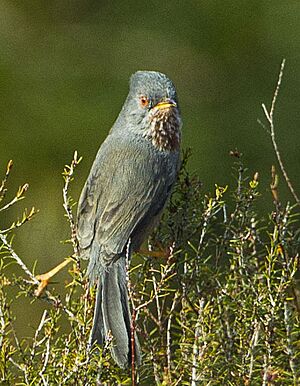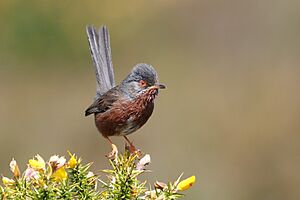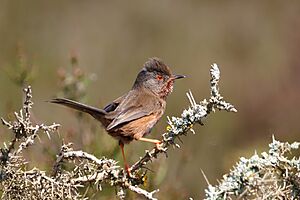Dartford warbler facts for kids
Quick facts for kids Dartford warbler |
|
|---|---|
 |
|
 |
|
| Male above, female below | |
| Conservation status | |
| Scientific classification | |
| Synonyms | |
|
The Dartford warbler (Curruca undata) is a small songbird. It lives in the warmer areas of western Europe and northwestern Africa. This bird has a long, thin tail and a pointed beak.
Adult male Dartford warblers have grey-brown feathers on their backs. Their undersides are a dull reddish-brown. The middle of their belly is a dirty white. They have light spots on their throat and a red ring around their eyes. Female Dartford warblers look similar but are usually less grey on top and paler underneath.
These birds usually stay in their breeding areas all year. However, some may move short distances. Their breeding range stretches from southern England to the heel of Italy.
Contents
About the Dartford Warbler's Name
The Dartford warbler was first described in 1776. A Welsh naturalist named Thomas Pennant gave it its English name. He based his description on two birds found near Dartford in Kent, England.
Later, in 1783, a Dutch naturalist named Pieter Boddaert gave the bird its scientific name, Motacilla undata. The word undata means "with wavy markings." This name came from a drawing of the bird from Provence, France.
There are three main types, or subspecies, of Dartford warblers:
- C. u. dartfordiensis: Found in south England and northwest France.
- C. u. toni: Found in northwest Africa.
- C. u. undata: Found in the Iberian Peninsula (Spain and Portugal) and southern France.
What Does a Dartford Warbler Look Like?
The Dartford warbler is a small bird, about 13 centimeters (5 inches) long. It has a long tail compared to other warblers. Its feathers are quiet, muted colors. These colors help it blend in with its habitat. This includes dry plants, old wood, and greyish wood.
Male and female Dartford warblers have slightly different looks. The male has a grey back and head. Its underside is reddish, and it has a red eye. The reddish throat has white spots. Some males might have bluish-grey or brownish-grey backs and heads.
The female is paler underneath, especially on her throat. She is also a browner grey on top. Her throat has white spots, but they are smaller than the male's. Young birds look similar to the females.
Where Do Dartford Warblers Live?
Dartford warblers are not very common. The largest groups of these birds live in the Iberian Peninsula (Spain and Portugal). Other groups are found in much of France, Italy, southern England, and south Wales.
In Africa, they are found in small areas in the north. They spend their winters in northern Morocco and northern Algeria.
Dartford Warbler Habits and Lifestyle


How Dartford Warblers Breed
Dartford warblers start breeding when they are one year old. They usually stay with the same partner for a long time. Sometimes, the male builds a few simple nests. The female then chooses one for breeding. More often, both birds help build the main nest.
In southern England, these birds breed on heathlands. They often nest in common gorse or common heather bushes. The nest is shaped like a cup and is usually in dense bushes. It is often less than 60 centimeters (2 feet) off the ground. The nest is made mostly of grasses. It is lined with finer materials like thin roots and feathers.
Eggs are laid from early April in southern France and Spain. In southern England, they are laid from mid-April. A female usually lays 3 to 5 eggs. The eggs are smooth and shiny. They are white or sometimes pale green. They have brown speckles, often more at the larger end. The eggs are about 17 x 13 millimeters (0.7 x 0.5 inches) in size.
The female mainly sits on the eggs to keep them warm. This takes 12 to 14 days. Both parents feed the baby birds, called chicks, with insects. The chicks leave the nest 10 to 14 days after hatching. Their parents then feed them for another two weeks. Dartford warblers usually raise two, and sometimes three, groups of chicks each year.
What Dartford Warblers Eat
Dartford warblers live in open fields with low, bushy plants. They are common in areas with heather. In winter, they might visit towns. However, they always look for food within shrubs in these areas. They build their nests in thorny bushes close to the ground.
These warblers mostly eat insects. Their diet includes caterpillars, butterflies, beetles, and spiders.
The song of the Dartford warbler is a special rattling sound.
Protecting the Dartford Warbler

Dartford warblers almost disappeared in the United Kingdom during the very cold winter of 1962-1963. The number of pairs dropped to only ten. These birds are also sensitive to dry weather. Droughts can affect their breeding or cause fires on the heathlands. This happened in England in 1975 and 1976. Almost all young birds did not survive their first year then.
However, this species can recover well if their habitat is good. They also need favorable temperatures and rainfall. This is because they can nest many times and their young have a good survival rate. They have recovered in some parts of the UK. But their numbers are now decreasing again in other areas where they live.
The Dartford warbler lives only in western and southern Europe. In 2012, there were an estimated 1.1 to 2.5 million breeding pairs. Most of these were in Spain, with about 983,000 to 1,750,000 pairs. The number of birds in Spain seems to be going down. This is likely due to losing their suitable habitat. Because of this, the International Union for Conservation of Nature lists the species as "Near Threatened." This means they could become endangered soon.
Since 1963, the climate has become warmer. This has helped the UK population grow to over 2,500 pairs by 2006. They have spread to new areas, even higher up and further north. This is likely due to milder winters. The Dartford warbler population in the UK is expected to keep growing.
However, future climate predictions for Europe show that by 2080, over 60% of their current European range might not be suitable for them. There is already evidence of this happening, with big declines in Spain and France. If these declines in southern Europe continue, the UK will become very important for protecting this species worldwide.



